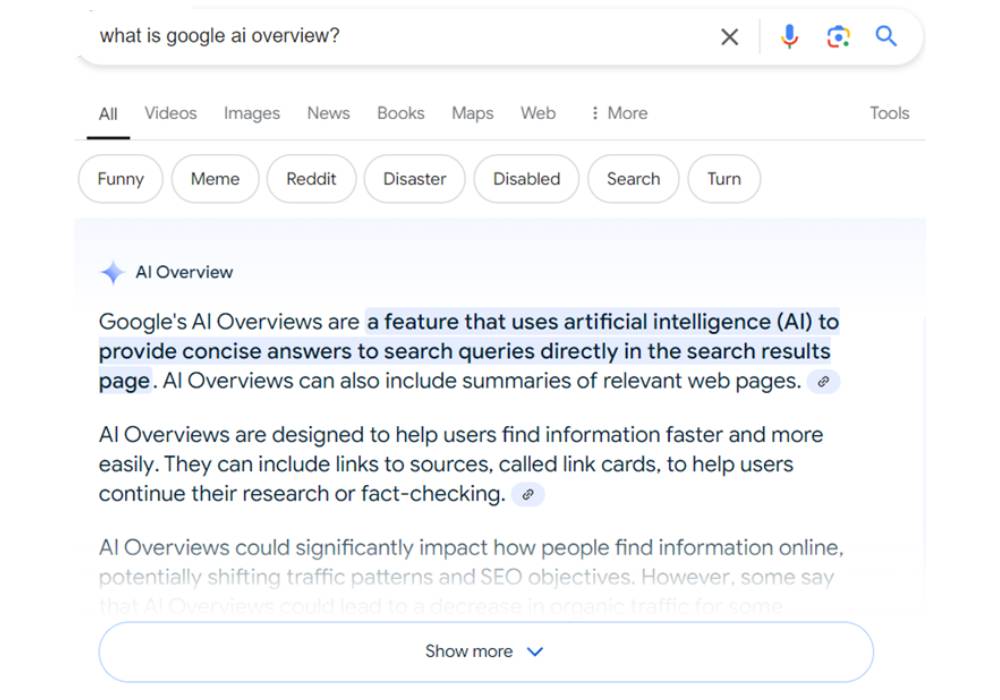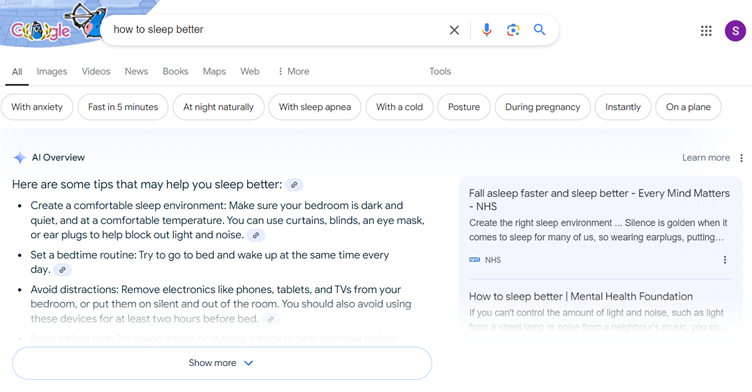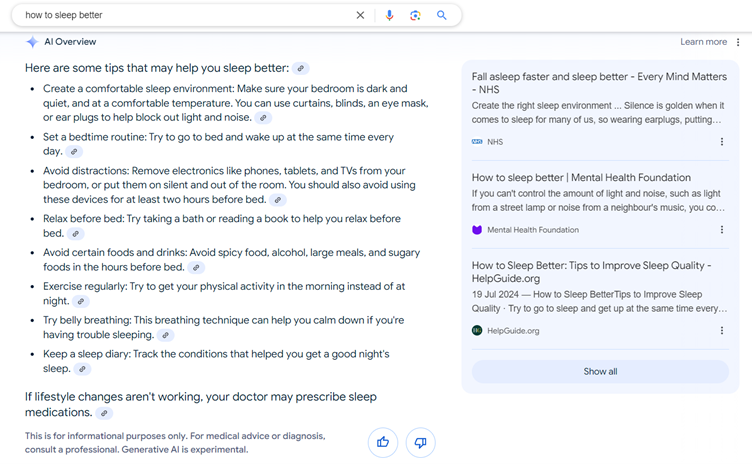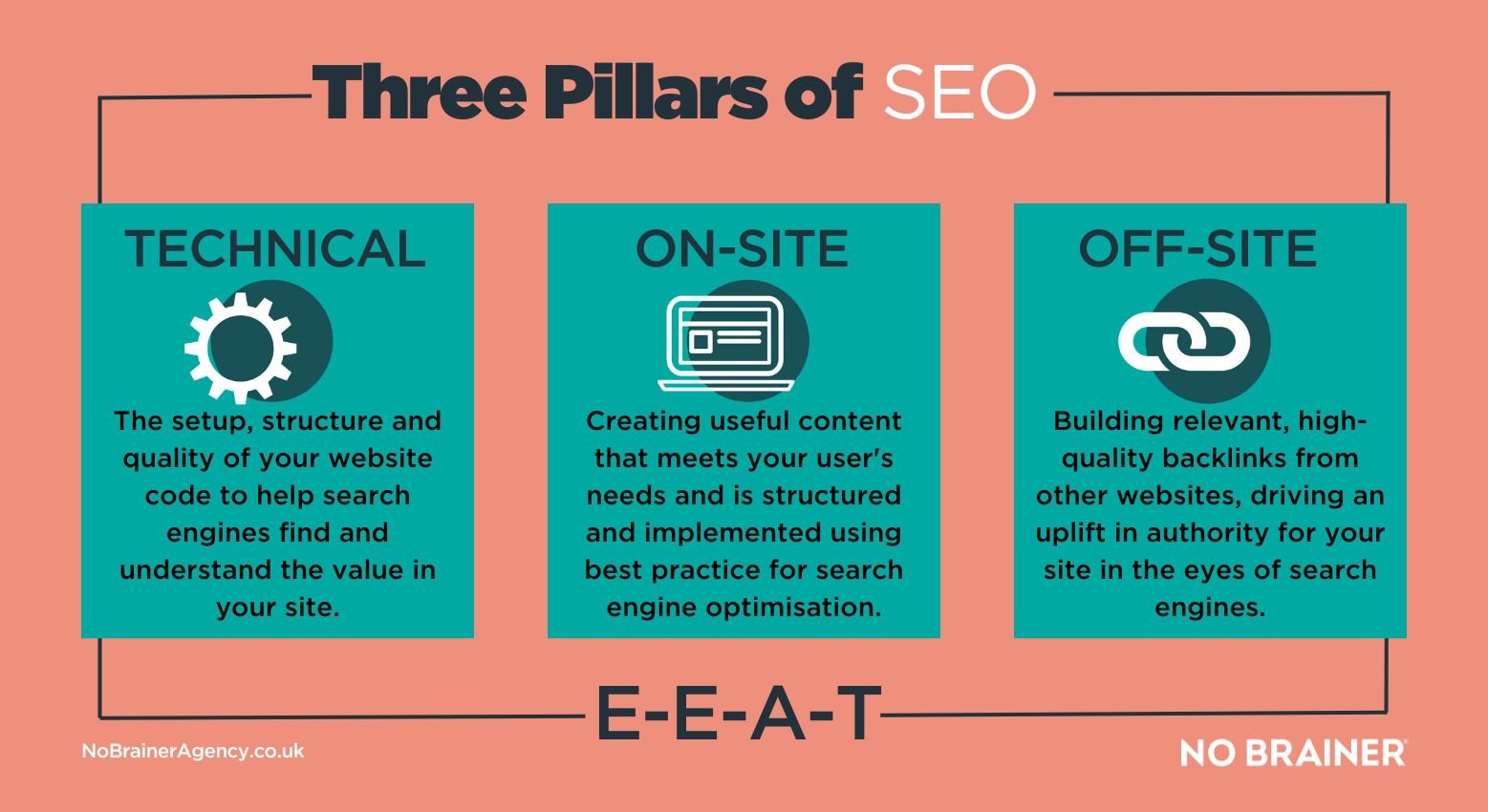If you use Google search with any frequency then you can’t have escaped noticing the steady rollout of Google’s AI Overviews in the last few months. Initially launched for US searches in mid-May 2024, many searches in the UK now also display a Google AI overview showing above the standard search results. This is now sometimes the case even if you’re not logged into a Google account when using the search engine.
In this article, we look at what Google AI Overviews actually are, whether businesses should be optimising their websites to try and appear in them and how to do so without compromising on other aspects of SEO performance.
What are Google AI Overviews?
Google’s AI Overviews are essentially a search results feature offering an AI-generated summary of information, based on a number of different online sources, including the likes of Reddit, in response to the user query.
The idea is for AI Overviews to give users a quick response to fairly complex queries, so they don’t have to click on multiple search results, or make several slightly different searches, to find out what they want to know, especially if they are looking for top-level information. The AI Overview does include links to the sources of the information it uses if searchers want to click through and find more detail or context on the original website.
In theory, AI Overviews could potentially mean that the number of people scrolling down the results page to (and clicking on) actual organic search results could shrink. Leading to what is known as zero-click searches, where users find what they need in Google Search without having to visit any websites at all.
While Google taketh away with one hand, they potentially giveth with the other, because AI Overviews do present some opportunities for the websites that appear in them.
- The prominent source placement in the Overviews could increase the original content’s visibility and bring more clicks.
- Google AI Overviews could also potentially help with pre-qualifying visitors, because they’ll only click on the source link in the Overview if the content they’ve already seen interests them and they want to engage further. The number of visitors arriving via search may be smaller, but they could be more likely to convert.
How do Google AI Overviews work?
Google AI Overviews essentially use their own generative AI technology (which they call Gemini) to populate the content within them from online sources. The AI model used has evolved from Google’s Search Generative Experiences (SGE), which was an opt-in experiment they ran in 2023/24 on how generative AI could assist with search. Google AI Overviews is the result of that experiment.
Google’s system decides when a specific query triggers an AI Overview and will show several pieces of information, usually in bulleted form, in a compact window that can be expanded by the user.
According to Google, AI Overviews aren’t generating their output from training data like most AI models do, but are integrated with Google’s core web ranking systems so can actually carry out search engine-like tasks. Google claims that AI Overviews will only show information that is ‘backed up by top web results’.
In practice, this is what AI overviews look like:
Taking an example of a desktop search, with someone looking for advice on how to sleep better, they are shown a panel including some visible tips on the left and some heavily truncated sources on the right.
Above the overview appear related search suggestions for the searcher to drill down further if needed e.g.
- How to sleep better with anxiety
- How to sleep fast in 5 minutes
- How to sleep at night naturally
- How to sleep better with sleep apnea
- How to sleep better with a cold
- How to sleep better during pregnancy
These types of suggestions can appear in non-AI Overview search results as well, but these are much more specific and relevant to the original query.
When fully expanded, the Overview shows more sleep suggestions, before ending on a disclaimer and enabling user feedback with the thumbs up or down icons.
However, in order to see all of the websites used as sources, the user has to click again on the right panel’s ‘show all’ button, then navigate a scroll box to view the 10x additional source sites not shown above. The extra effort this takes means that users are very unlikely to click on a source website unless it’s one of those shown in the original Overview panel, preferably in first or second place.
Why isn’t there a Google AI overview for every search?
Google hasn’t yet gone into a huge amount of detail about what kind of search triggers an AI Overview to appear in the results, but they do maintain that this search feature is meant for complex queries primarily.
Those behind the SEO tool, Advanced Web Ranking, have done a study based on thousands of test examples. Amongst other findings, the study indicates that:
- Five-word queries most frequently trigger an AI Overview
- AI Overviews do not show for brand-related searches
- Keywords related to health and/or safety are more likely to trigger AI Overviews
- Keywords with navigational intent are less likely to result in an AI Overview.
The same search on different devices can also have different results in terms of whether an AI Overview shows up. The query ‘how to sleep better’ didn’t trigger an AI Overview on mobile but did on desktop, for example.
If Google AI Overview essentially generates from scratch each time someone inputs a query, then it could theoretically display different information and sources frequently for the same query.
Is it worth trying to optimise content to appear in Google AI overviews?
Whether it’s worth allocating time and resources to trying to appear in Google AI Overviews will very much depend on your specific business and what you do, as well as balancing this with the wider SEO and marketing strategy.
If your business sees lots of value in traffic that is looking for informational content, appearing in AI Overviews could certainly be beneficial to your business. That said, there are no guarantees that optimising for AI Overview will get you featured in the kinds of results you want, especially if all your competitors are already ahead of you on that.
However, it’s also worth noting that many of the things that should help you potentially appear in AI Overviews are just great SEO practice anyway, so should have organic search benefits for your website in any case.
How to optimise content for Google AI overviews
A recent study by the seoClarity team, where they analysed thousands of keywords and search results, including those in AI Overviews, found that 99.5% of the time, one or more of the top 10 web results was included as a source in the Google AI Overview for that query.
This appears to be something that has changed over time since the rollout began, potentially because of the highly publicised ‘fails’ that swiftly followed the initial launch.
What it does mean, at the present time, is that optimising your website and content effectively for organic search in general can also help boost your chances of appearing in AI Overviews.
What Google say about how to rank in their AI Overviews
Google specifically say that “there is nothing special for creators to do to be considered (for AI Overviews) other than to follow our regular guidance for appearing in search”.
Fundamentally, this means following technical SEO best practice, avoiding spammy tactics, earning good quality backlinks and ensuring all content on the website aligns with Google E-E-A-T principles.
Other ways to optimise for Google AI Overviews
Along with following good SEO best practice and building site authority that way, we do think that there are some other ways that businesses and brands can stack the deck in your favour when it comes to Google AI Overviews. These include:
- Identify existing AI Overviews you want to appear in, and cover the topic more thoroughly on your own site than is currently seen in the Overview.
- Create new (or update existing) helpful content around long-tail informational queries that are more likely to trigger an AI Overview.
- Answer the main question or query really clearly and directly, preferably in the first sentence. You can then add more supplementary information in additional paragraphs.
- Structure your content with clear subheadings, bullet points and concise paragraphs so Google can understand it easily.
- Revisit existing content regularly and update if necessary to make sure it’s as accurate, relevant and useful to users as possible.
How do I know if my website appears in Google AI Overviews?
Say that you decide to spend some time and effort on optimising some of your content for AI Overviews. How can you tell if your hard work has paid off? Or how can you see whether you already feature in any AI Overviews?
Apart from manually checking your keywords in Google or randomly stumbling on your website appearing in an AI Overview, is there an easy way to tell whether you’re appearing in them and for what query?
The simple answer is… not really, but kind of.
Google has said that AI Overview data is available in Google Search Console (GSC), but unfortunately it can’t be filtered or viewed separately from any of your other data. This means that impressions and clicks resulting from appearing in AI Overviews are lumped in with the rest of the page or query data and you can’t be sure which are from search results and which are from Overviews.
In GA4, any traffic resulting from clicks in AI Overviews will just show as standard organic traffic.
Third-party tools to track Google AI Overviews
So, if Google doesn’t provide the data, you are left with third party tools to try and track your appearances in AI Overviews. A number of paid tools currently claim to be able to help you track your Google AI Overview appearances and the impact it’s having on your online visibility, although this may not yet be guaranteed on UK data. At the time of writing, rollout of AI Overviews here is still in process and not as widespread as in the US. These tools include:
- Semrush – this SEO tool includes a SERP features filter in their position tracking tool, which has an option to view AI Overviews, so you can see which tracked keywords are appearing in them. As of early September 2024, you can also view some AI Overviews insights by using Semrush’s organic research function.
- Ziptie – they don’t currently offer their AI Overviews tracking in the UK, but they’re planning this soon and you can join their waiting list to find out as soon as they expand to cover this.
Google AI Overviews: What to do next
It’s clear that AI Overviews as we see them today are something that isn’t the finished article. The whole point of generative AI is that it keeps evolving, ‘learning’ and developing, so it’s important to bear that in mind when deciding on any further action you might want to take.
At No Brainer, we take the view that your entire SEO strategy, including AI Overview activities, should always primarily align with best practice principles and prioritise the informational needs of your audience. By optimising your website effectively with a user-first approach, you can potentially kill all the birds with the same stone and start to improve rankings in standard search results, appear in key AI Overviews and also in featured snippets.
If you’d like to know more about our approach to SEO and how we can help drive organic growth for your business, get in touch using the form below.












